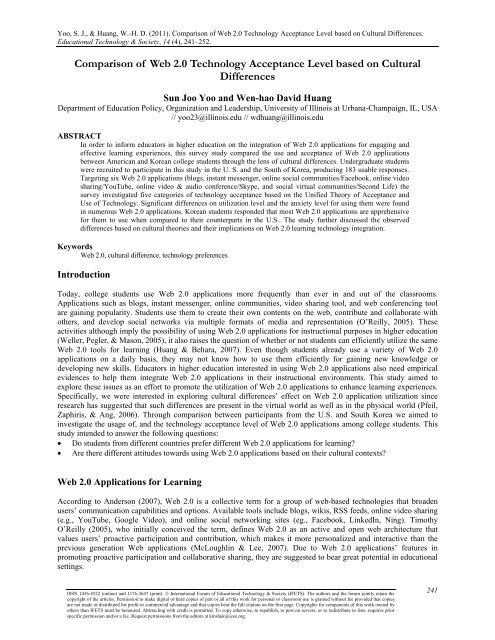October 2011 Volume 14 Number 4 - Educational Technology ...
October 2011 Volume 14 Number 4 - Educational Technology ...
October 2011 Volume 14 Number 4 - Educational Technology ...
You also want an ePaper? Increase the reach of your titles
YUMPU automatically turns print PDFs into web optimized ePapers that Google loves.
Yoo, S. J., & Huang, W.-H. D. (<strong>2011</strong>). Comparison of Web 2.0 <strong>Technology</strong> Acceptance Level based on Cultural Differences.<br />
<strong>Educational</strong> <strong>Technology</strong> & Society, <strong>14</strong> (4), 241–252.<br />
Comparison of Web 2.0 <strong>Technology</strong> Acceptance Level based on Cultural<br />
Differences<br />
Sun Joo Yoo and Wen-hao David Huang<br />
Department of Education Policy, Organization and Leadership, University of Illinois at Urbana-Champaign, IL, USA<br />
// yoo23@illinois.edu // wdhuang@illinois.edu<br />
ABSTRACT<br />
In order to inform educators in higher education on the integration of Web 2.0 applications for engaging and<br />
effective learning experiences, this survey study compared the use and acceptance of Web 2.0 applications<br />
between American and Korean college students through the lens of cultural differences. Undergraduate students<br />
were recruited to participate in this study in the U. S. and the South of Korea, producing 183 usable responses.<br />
Targeting six Web 2.0 applications (blogs, instant messenger, online social communities/Facebook, online video<br />
sharing/YouTube, online video & audio conference/Skype, and social virtual communities/Second Life) the<br />
survey investigated five categories of technology acceptance based on the Unified Theory of Acceptance and<br />
Use of <strong>Technology</strong>. Significant differences on utilization level and the anxiety level for using them were found<br />
in numerous Web 2.0 applications. Korean students responded that most Web 2.0 applications are apprehensive<br />
for them to use when compared to their counterparts in the U.S.. The study further discussed the observed<br />
differences based on cultural theories and their implications on Web 2.0 learning technology integration.<br />
Keywords<br />
Web 2.0, cultural difference, technology preferences<br />
Introduction<br />
Today, college students use Web 2.0 applications more frequently than ever in and out of the classrooms.<br />
Applications such as blogs, instant messenger, online communities, video sharing tool, and web conferencing tool<br />
are gaining popularity. Students use them to create their own contents on the web, contribute and collaborate with<br />
others, and develop social networks via multiple formats of media and representation (O’Reilly, 2005). These<br />
activities although imply the possibility of using Web 2.0 applications for instructional purposes in higher education<br />
(Weller, Pegler, & Mason, 2005), it also raises the question of whether or not students can efficiently utilize the same<br />
Web 2.0 tools for learning (Huang & Behara, 2007). Even though students already use a variety of Web 2.0<br />
applications on a daily basis, they may not know how to use them efficiently for gaining new knowledge or<br />
developing new skills. Educators in higher education interested in using Web 2.0 applications also need empirical<br />
evidences to help them integrate Web 2.0 applications in their instructional environments. This study aimed to<br />
explore these issues as an effort to promote the utilization of Web 2.0 applications to enhance learning experiences.<br />
Specifically, we were interested in exploring cultural differences’ effect on Web 2.0 application utilization since<br />
research has suggested that such differences are present in the virtual world as well as in the physical world (Pfeil,<br />
Zaphiris, & Ang, 2006). Through comparison between participants from the U.S. and South Korea we aimed to<br />
investigate the usage of, and the technology acceptance level of Web 2.0 applications among college students. This<br />
study intended to answer the following questions:<br />
Do students from different countries prefer different Web 2.0 applications for learning?<br />
Are there different attitudes towards using Web 2.0 applications based on their cultural contexts?<br />
Web 2.0 Applications for Learning<br />
According to Anderson (2007), Web 2.0 is a collective term for a group of web-based technologies that broaden<br />
users’ communication capabilities and options. Available tools include blogs, wikis, RSS feeds, online video sharing<br />
(e.g., YouTube, Google Video), and online social networking sites (eg., Facebook, LinkedIn, Ning). Timothy<br />
O’Reilly (2005), who initially conceived the term, defines Web 2.0 as an active and open web architecture that<br />
values users’ proactive participation and contribution, which makes it more personalized and interactive than the<br />
previous generation Web applications (McLoughlin & Lee, 2007). Due to Web 2.0 applications’ features in<br />
promoting proactive participation and collaborative sharing, they are suggested to bear great potential in educational<br />
settings.<br />
ISSN <strong>14</strong>36-4522 (online) and 1176-3647 (print). © International Forum of <strong>Educational</strong> <strong>Technology</strong> & Society (IFETS). The authors and the forum jointly retain the<br />
copyright of the articles. Permission to make digital or hard copies of part or all of this work for personal or classroom use is granted without fee provided that copies<br />
are not made or distributed for profit or commercial advantage and that copies bear the full citation on the first page. Copyrights for components of this work owned by<br />
others than IFETS must be honoured. Abstracting with credit is permitted. To copy otherwise, to republish, to post on servers, or to redistribute to lists, requires prior<br />
specific permission and/or a fee. Request permissions from the editors at kinshuk@ieee.org.<br />
241

















